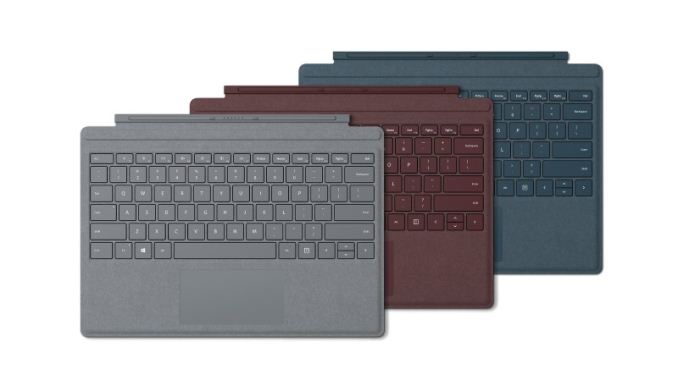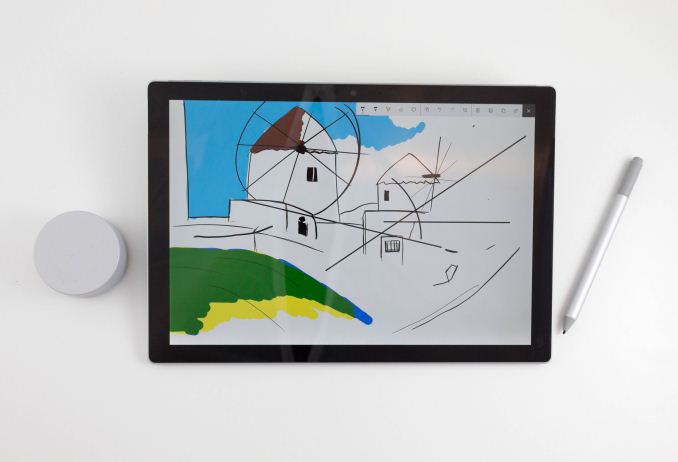The Microsoft Surface Pro (2017) Review: Evolution
by Brett Howse on June 15, 2017 9:00 AM ESTSurface Pro Signature Type Cover
It’s kind of funny that the current cover is still called the Type Cover, since the Touch Cover hasn’t been offered for several years now. Regardless, the latest Type Cover to be offered alongside the Surface Pro is a new version of the Signature model. The first Signature Type Cover was added to the Surface lineup shortly after the Surface Pro 4 was released, and it added a touch of luxury with an Alcantara fabric covering the keyboard.
The new Signature Type Cover will be offered in three colors, with Platinum, Burgundy, and Cobalt Blue options. It keeps the same design as the previous models, with 1.3 mm of key travel, and edge-to-edge island keys, so there’s not a lot of discuss there, but luckily the previous generation was already excellent.
The new Alcantara fabric is also covered with a polyurethane coating to improve durability. There’s certainly going to be some concern about how the fabric cover will hold up after several years of use and abuse, so the new coating should help alleviate some of that concern. The coating should also should help with liquid spills, and cleanup can be done with warm water and a mild detergent if needed. It feels like there’s almost no doubt that over time, the fabric will get a bit beat up, but it really does offer a nice feel when carrying the Surface Pro, or typing.
The New Surface Pen
Microsoft has been actively pushing the pen and inking experience in Windows for several years, so it makes a lot of sense that they would offer it in their own hardware products. They’ve continually improved the pen and ink on Surface for the last several years, and with the new Surface Pro, there is once again a new, improved pen.
Everyone loves to discuss the levels of sensitivity on digital pens, since unlike their analog cousins, there is always a graduated step, with the hope that there will be a small enough graduation that it’s difficult for a person to notice it. Surface Pro 3 was the first Pro model to drop the Wacom digitizer and move to an N-Trig pen technology, that Microsoft would end up acquiring shortly after. The Surface Pro 3 dropped from 1024 levels of sensitivity of the Wacom powered Surface Pro 2, to just 256 levels, but the Surface Pro 4 brought that back up to 1024 levels of sensitivity. For most people, that’s likely enough, but with Microsoft now courting the creativity crowd, the pen needed to improve further, and the new Surface Pen now offers 4096 levels of pressure sensitivity.
That’s always been the easy specification to quote for a pen, but there is a lot more to a pen experience than the levels of sensitivity. For pen fans, they’ll be happy to know that Microsoft has not overlooked those other factors with the latest generation.
One of the best features of the pen launched with the Surface Pro 4 was the tip feel. Unlike older pens, it offered a bit of traction on the display, and really made it feel more like it was actually drawing on the display. Like the previous pen, the new one also features replaceable tips, giving a choice of wider or thinner pen tips. The new pen keeps that same display friction too, which really makes it feel connected to the display.
Pen latency is arguably one of the most important aspects of a good digital inking experience, and it’s often one that gets less emphasis than other stats like pressure levels, but here the new pen improves again over the previous model, with just 21 ms of latency. Microsoft has a custom display controller to sense the pen, and with the lower latency, the latest generation is easily the best performing pen on Surface yet. One easy test to try is to draw circles on the screen quickly. The Surface Pro 4 would always have the ink lagging slightly behind where the pen was if the speed was moving quickly enough, but the new Surface Pro doesn’t have this issue at all. The ink appears to stay right under the pen.
Another unheralded feature is the amount of pressure required to start drawing, and the new Pen improves this dramatically. The outgoing version required 20 grams of force to be detected, but the new pen is just 9 grams, allowing much lighter drawing and shading options.
Finally, the one piece of the pen puzzle that Microsoft had really been lagging on was tilt support, and with the new pen, that is now available as well.
The pen is still powered by a AAAA battery, rather than being rechargeable, and battery life is expected to be around a year. The new pen also drops the pocket clip, but keeps the ability to stick to the Pro with magnets for transport. It would be nice to see a more solid mechanical device to hold the pen to the Surface, since the magnets are strong but still allow the pen to be dislodged in a bag. But for now, keep a close eye on the pen.
The new Surface Pen will work on any Surface device all the way back to and including the Surface Pro 3, and since many of the new features are part of the pen hardware, they will automatically work with other Surface devices with most of the features available. Meanwhile Microsoft is looking to upgrade the firmware of their pen controller of other Surface devices, such as the Surface Studio, to bring all of the improvements to the older hardware. The Surface Studio will really benefit from this Pen.
The final change from the Surface Pro 4 is that the pen is no longer included with the Pro. That’s because not all customers were using the pen, and it seems pretty plain that this was done in part to allow Microsoft to cut the cost of the device a bit, as we saw with the price-reduced Surface Pro 4 from earlier this year. Meanwhile for those users who do buy the new Surface Pen, it's available in colors to match the Signature Type Cover.













124 Comments
View All Comments
mkozakewich - Saturday, June 17, 2017 - link
I swear I say this every time, but it bears repeating: One of the original ideas about ultrabooks was that we could throttle them while mobile, but then run them at full power by using some kind of cooling dock. Same thing here: If you had (or made?) something that cools off the chassis, it'll reach higher performance levels. Using it outside on a cold and windy day will give you more frames per second. Stuff like that.tipoo - Monday, June 19, 2017 - link
Yup, very interested about the fanless 15W i5 and how well that can keep up. In theory it would act pretty Core M-ey.anactoraaron - Thursday, June 15, 2017 - link
I remember owning a pro 4 and being disappointed learning that the review samples used a faster ssd. All retail units had much slower ssds and a ridiculous amount of light bleed on the displays. I had one at launch (and returned a few to try and get less light bleed and perhaps the faster ssd used by the review units) but the first time I got a blue screen negating over an hour of work it had to go. It was a great concept, as I ultimately went with the Vaio Z Canvas (during the fire sale). The Vaio has been by far the better option, with plenty of ports and power (not to mention it also has a better display) to its advantage over the surface pro.SaolDan - Thursday, June 15, 2017 - link
I actually owned a sp4 i5 with the toshiba ssd and it had faster write. about 1GBps write speed. But tbe screen developed a small preasure point and i got it replaced. I got a samsung ssd on the replacement. not as fast.samnish - Thursday, June 15, 2017 - link
As an owner of Surface Pro 2 and 4, I must say, I went from loving the idea to hating the series. To list a few issues:- Normal sleep mode never works. Either it wakes up to a black screen, or it used up all the battery while sleeping. It is pretty much required to disable sleep and use hibernation instead.
- The Wacom pen on SP2 worked well. The one on the SP4 is a huge step downwards. If you want to draw a straight line, you need to draw it by the edge of the screen, because when you draw in the middle of the screen it'd give you a squigly line. Happaned even after exchanging for another one at MS store.
- On the SP4, I encountered a bug where a process "Microsoft IME" would hog up 100% of the CPU. If memory serves, it was introduced by the Anniversary Update. After a lengthy thread on Microsoft forum with many other victims, MS did fix it. But it took them 3 months.
- When charging, if the SP4 is grounded slightly different than myself, the touchpad would have an jittery response. I have to touch the chassis of the SP4 with my other hand to make the touchpad work normally. Happaned even after exchanging for another one at MS store.
This is enough examples. The Surface Pro series was Microsoft's poster child, yet they couldn't even get all the basic laptop features working stably for 4 generations. With laptops from other manufacturers, one can defend MS by saying "they have many different hardware to support, drivers take time to mature". Sure. What about the Surface Pro series? You can't really defend them with the same points - all the hardware is chosen and supported by Microsoft themselves. By Surface Pro 4, they really shouldn't still be struggling with delivering firmware that don't break your hardware and a sleep mode that works. I hope the new Surface Pro fares better this time on these departments, but I don't have high hopes for them. Microsoft has a much stronger showing for innovation in recent years, yet the hardware that they deliver are full of small glitches, and the stability of their consumer operating system has been such a mess.
mkozakewich - Saturday, June 17, 2017 - link
I had a lot of problems with the little things. When I close my cover, the touchpad starts activating the screen, causing it to wake from sleep or start dragging icons around. I'm actually having a more consistent time with my $400 Chuwi. It feels weirdly magical to be able to close it without worrying about it waking up again.tipoo - Thursday, June 15, 2017 - link
Pretty curious about that 15W fanless middle tier. I'm assuming it would act pretty Core M-ey, but I wonder if it would do worse than silicon selected for the lower TDP, or if the chips are pretty much the same with different TDP-Downs.id4andrei - Thursday, June 15, 2017 - link
The Core M SP4 had great cooling. As long as the fanless i5 throttles at about the same threshold as ultrabooks with fans it would be a success.KPOM - Sunday, June 18, 2017 - link
The 15w cpus can downvolt to 7W. I wounded if that is what Microsoft is doing with the i5.tipoo - Monday, June 19, 2017 - link
Yeah that's what I meant about the TDP-Down, in theory a 15W chip with a tdp-down to 7W and a 5W chip with a TDP-up to 7W would act the same as the silicon is the same.